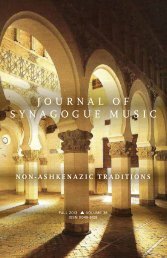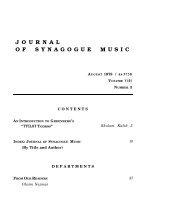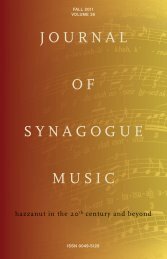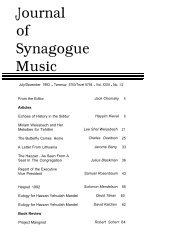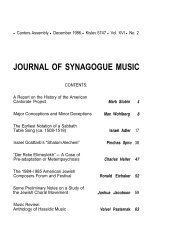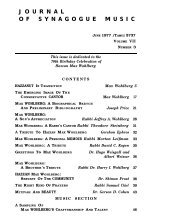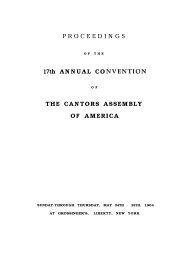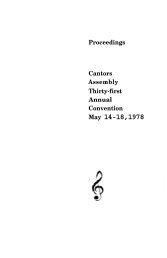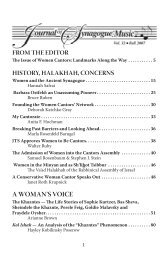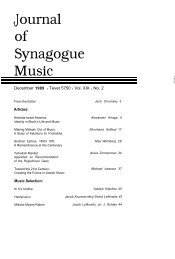ninth annual conference-convention - Cantors Assembly
ninth annual conference-convention - Cantors Assembly
ninth annual conference-convention - Cantors Assembly
You also want an ePaper? Increase the reach of your titles
YUMPU automatically turns print PDFs into web optimized ePapers that Google loves.
scholars and the public at large with this kind of<br />
knowledge. Moreover, considering the fact that all<br />
scholarly disciplines are usually interrelated in one<br />
way or another, it is quite likely that this musical<br />
material will turn out to be of no small value in other<br />
branches of Jewish learning, such as Hebrew accentuation<br />
and poetic rhythmics, for instance. Above ali,<br />
the melodic restoration referred to will undoubtedly<br />
be of considerable interest to the Christian world,<br />
which has always shown a serious concern about the<br />
wellsprings of its tradition, of which ancient Hebrew<br />
music forms an integral part.<br />
Secondly, there is the esthetic aspect. To be sure,<br />
we all believe that, despite occasional digressions,<br />
there is a more or less constant development in all<br />
fields of art, including music. But this development<br />
never obliterates in any way, or even devaluates, earlier<br />
artistic achievements no matter how primitive<br />
they may happen to be. There is a great difference,<br />
in this respect, between things spiritual and material.<br />
In our external civilization, the latest inventions always<br />
have an advantage over earlier ones-the electric<br />
bulb is superior to the kerosene lamp, and the<br />
latter is more practical than the candle. This, however,<br />
is not necessarily true in the domain of culture,<br />
where the candle, figuratively speaking, may not only<br />
be equal but sometimes even preferable to the electric<br />
bulb. One will frequently find a certain pristine grandeur<br />
and austerity, as well as many other specific and<br />
magnificent traits in very early sculptures, paintings<br />
and melodies, which can scarcely be expressed by the<br />
technical intricacies of modern art. This, naturally,<br />
applies also to the ancient Hebrew chants which, when<br />
extensively restored, may have an esthetic significance<br />
in the future development of Jewish music that cannot<br />
be fully estimated at the present time.<br />
Thirdly, we have the liturgical aspect. It is common<br />
knowledge that an overwhelming proportion of<br />
Jewish liturgy is based on ancient texts. But the<br />
actual melodic material that has been used for these<br />
texts during the periods of Jewish dispersion is largely<br />
of a much later, and frequently alien, origin. Hence<br />
there exists a perennial schism between the sacred<br />
word and its musical ‘envelope’ in the traditional<br />
Jewish liturgy, which is often quite obvious even to<br />
a layman. That this unfortunate situation needs some<br />
sort of rectification will hardly be contested. For the<br />
effect of a pronounced word in a musical performance,<br />
particularly of a liturgical character, greatly depends<br />
on the quality of its melodic counterpart and the inner<br />
unity of both. It follows as a matter of course that<br />
the restoration of ancient Hebrew melodies and the<br />
appropriate application of their many historically<br />
graded ‘layers’ to various ancient texts will go a long<br />
way towards retrieving this long-lost unity, so badly<br />
needed in our somewhat unbalanced liturgical ministrations.<br />
Fourthly, we may point out the ever substantial aspect<br />
of technical usefulness. This indeed is quite evident<br />
from the long-range method of Hebrew melodic<br />
restoration advanced in the earlier part of the present<br />
-35-<br />
discussion. For, by studying systematically the mechanism<br />
of spontaneous melodic changes (both safe and<br />
risky) that have taken place through the centuries of<br />
Jewish music history, the practicing cantor will learn<br />
how to ornament consciously and intelligently the<br />
simple ancient chants, wherever so desired, without<br />
affecting their integral character.<br />
And finally we arrive at the fifth aspect, the national.<br />
It would seem, generally, that the real worth<br />
of any nation is measured by the amount and originality<br />
of its contributions to the world’s culture. However,<br />
though the amount of such contributions depends<br />
in no small measure on the number of outstanding<br />
personalities and therefore, ultimately, on total population,<br />
their originality stems largely from the intensity<br />
of national consciousness, in any given instance.<br />
This applies with particular force to the domain of<br />
arts, in which a great many, if not always the highest<br />
achievements bear a distinct national stamp. Now,<br />
judging from the few examples of ancient Hebrew<br />
chants that have come down to us in a relatively unadulterated<br />
form, this melodic material has all the<br />
marks of an original production and, for this reason,<br />
harbors within itself immense creative potentialities.<br />
Its restoration on a large scale may well lead to an<br />
extensive re-orientation of Jewish composers with regard<br />
to their methods and style. And this, in turn,<br />
may bring to the fore a new stream of Jewish works<br />
which, because of their intrinsic originality, rooted in<br />
solid foundations, will stand a good chance of gaining<br />
permanent recognition on a par with the greatest<br />
musical contributions of all the other nations of the<br />
world.<br />
(The Musical Examples for this Paper were<br />
performed by Hazzan Jacob Hohenemser)<br />
EVENING SESSION<br />
CONCERT OF JEWISH MUSIC<br />
1. *Tsur Yisroel . . . . . . . . . . . . . . . . . . . . Ernest Blooh<br />
*V’Ohavto . . . . . . . . . . . . . . . . . . . . . . . Ernest Blooh<br />
Omar Rabi Elozor . . . . . . . . . . Arr.: L. Saminsky<br />
*In honor of the 75th Birthday of Ernest Blooh.<br />
MR. RAPHAEL EDGAR<br />
Candidate for Graduation - The <strong>Cantors</strong> Institute<br />
2. V’Haarev No . . . . . . . . . . . . . . . . . . P. Jassinowsky<br />
Al Tiro . . . . . . . . . . . . . . . . . . . . . . . . David Roitman<br />
Misratzeh B’rachamim. . . Arr.: Davidson-Brockman<br />
HAZZAN HARRY BROCKMAN<br />
Cong. Shaare Torah, Brooklyn, N. Y.<br />
3. Misod Chachawmim . , . . . . . . . . . . . . . . Traditional<br />
Adir Adirenu . . . . . . . . . . . . . . . . . . . . . . Traditional<br />
Uvchen Ten Kawvod . . . . . . . . . . . . . . . . Traditional<br />
Arranged by Hazzan Segal<br />
HAZZAN ROBERT H. SEGAL<br />
Bnai Jeshurun, New York, N. Y.<br />
MR. SHELDON ROSENBAUM, Accompanist<br />
INTERMISSION



